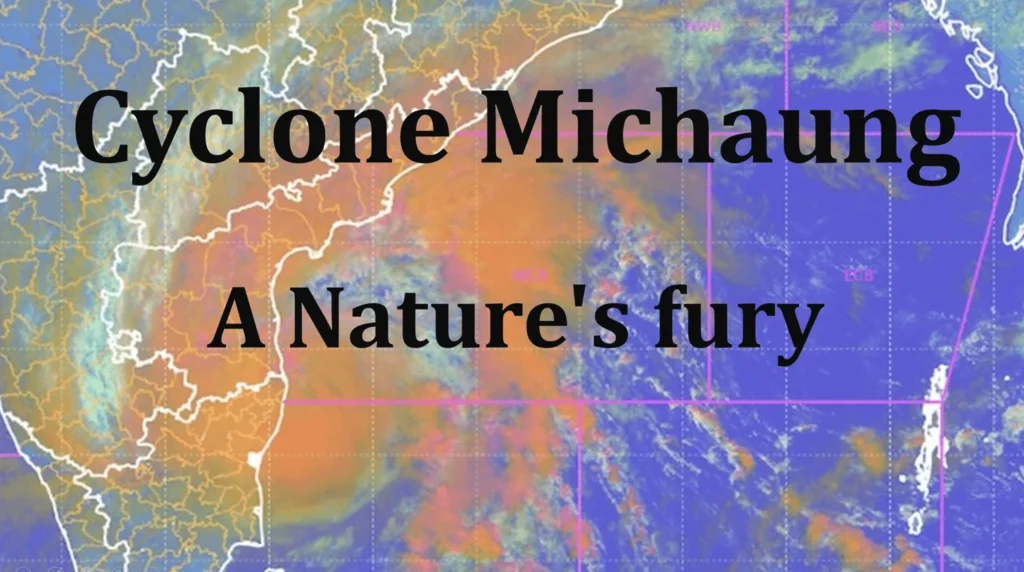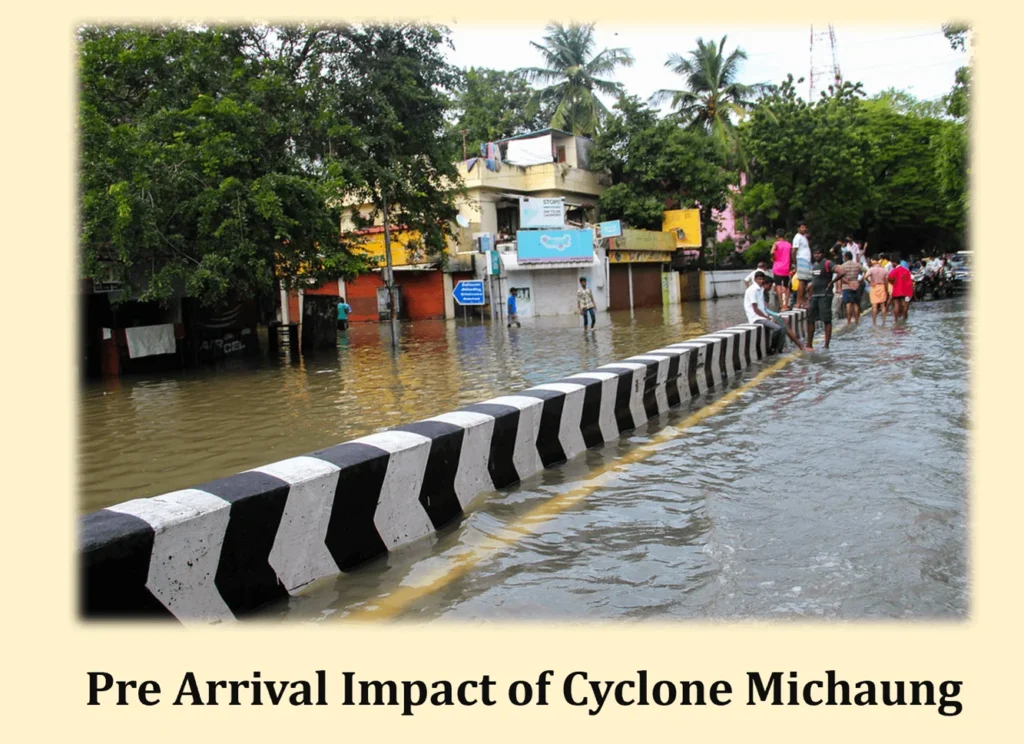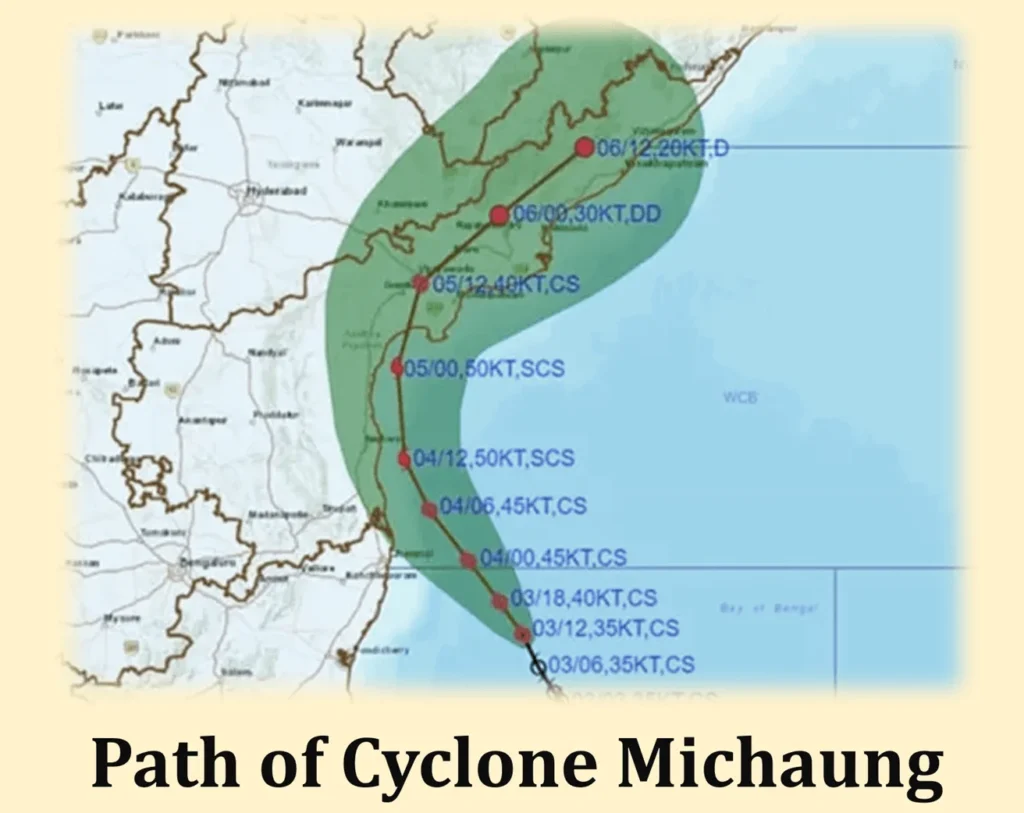
Introduction
The India Meteorological Department (IMD) has raised an alarm with an imminent threat posed by Cyclone Michaung, expected to hit Andhra Pradesh and Tamil Nadu, potentially causing widespread havoc. Scheduled to make landfall on Tuesday, the cyclonic storm has triggered extensive preparations aimed at minimizing its impact and safeguarding residents.
Understanding Cyclones and Their Formation
Cyclones are powerful weather systems characterized by a low-pressure center and organized thunderstorms that produce strong winds and heavy rainfall. These atmospheric phenomena, also known as hurricanes or typhoons depending on the region, have a significant impact on coastal areas worldwide.
Factors Contributing to Cyclone Formation
Cyclones are formed due, to a combination of factors. Firstly they rely on ocean temperatures of least 26.5°C (80°F) to gain the energy needed for their development. Additionally cyclones thrive in conditions that’re both moisture rich and unstable. Lastly the existence of a existing disturbance like a tropical wave or an area of low pressure is essential, in triggering the formation of cyclones.
Studying cyclones is of utmost importance for preparedness. By understanding their characteristics, formation processes, and contributing factors, meteorologists and disaster response teams can enhance early warning systems, evacuation plans, and infrastructure resilience to mitigate the potential impact of these destructive weather events.
Overview of Cyclone Michaung
Likely Impact of Cyclone Michaung
Cyclone Michaung, named by the India Meteorological Department (IMD) based on internationally agreed-upon naming conventions specific to different regions. The cyclone is expected to hit Andhra Pradesh and Tamil Nadu on December 5th resulting in damage and leading the IMD to issue an alert. It originated in the Bay of Bengal. Has rapidly intensified, becoming stronger and more destructive as it approaches the coast of India.
The pre landfall impact is that the likely affected regions of Andhra Pradesh and Tamil Nadu are experiencing torrential rainfall, powerful winds, and storm surges. It has the potential to cause harm to the infrastructure, including houses, roads and power lines. Moreover, this scenario could result in loss of life displacement of communities and disturbance of services which would make the local population more susceptible.

It is heartbreaking to note that heavy rainfall, in Tamil Nadu has already caused five reported fatalities in Chennai as a result of rain related incidents amplifying worries, about the impact of the cyclone. In response, a red alert has been issued in crucial areas of Andhra Pradesh to prompt comprehensive precautions against the anticipated devastation.
Geographical Location and Affected Regions
Cyclone Michaung will make landfall in the coastal regions of Andhra Pradesh and Tamil Nadu, both located in the southern part of India. Andhra Pradesh, famous, for its coastline along the Bay of Bengal might experience the fury of the cyclone before Tamil Nadu. These states have a population density and numerous towns and cities along the coast which makes them especially susceptible, to the effects of cyclones.
Intensity and Destruction Caused by Cyclone Michaung
Cyclone Michaung is exhibiting an unprecedented intensity, with wind speeds may reach up to 200 kilometers per hour (124 miles per hour). Such extreme wind forces may uproot trees, damage buildings, and caused severe flooding, leaving a trail of destruction in its wake. The cyclone’s intensity highlights the urgent need for accurate prediction and efficient response strategies to minimize the potential harm inflicted upon coastal communities.
Significance of Studying Cyclone Michaung
Lessons Learned from Past Cyclones
Cyclone Michaung yet again serves as a reminder of the lessons learned from previous cyclones. By thoroughly studying past events, meteorologists can improve their understanding of cyclone behavior, enabling them to refine prediction models and enhance emergency response plans. Each cyclone offers valuable insights into the impact of extreme weather conditions and the vulnerabilities of affected regions, helping authorities prevent and mitigate future disasters.
Early Warning Systems and Associated Preparedness
The impact of cyclones can be significantly reduced through preparedness and the implementation of robust early warning systems. In the case of Cyclone Michaung, the IMD has already issued red alert providing the necessary advance notice to activate emergency protocols and evacuate vulnerable areas. This timely warning system is playing a crucial role in saving lives and minimizing casualties.
Meteorological Features of Cyclone Michaung
Introduction to Cyclone Michaung’s Meteorological Features
To comprehend the meteorological features of Cyclone Michaung, it is crucial to examine the atmospheric conditions that facilitate cyclone formation. The interplay of various factors creates an environment conducive to the birth and intensification of these powerful weather phenomena.
Atmospheric Conditions Leading to Cyclone Formation
Cyclone formation requires specific atmospheric conditions, including warm ocean temperatures, high humidity, and weak vertical wind shear. The warm ocean acts as a heat reservoir, supplying energy to fuel cyclone development. Moisture-laden air rises rapidly, leading to the release of latent heat and the formation of towering cumulonimbus clouds, ultimately generating the cyclone’s characteristic thunderstorms.
Key Meteorological Parameters Associated with Michaung
Several meteorological parameters contribute to the intensity and behavior of Cyclone Michaung. The central pressure within the cyclone, wind speed, and rainfall rates provide critical insights into its power and potential hazards. These factors are used by meteorologists to evaluate a cyclone’s path and predict potential dangers upon impact.
Acknowledging Sea Surface Temperatures’ Significance
Cyclones are influenced by sea surface temperatures both in their formation and severity. The warmth of ocean waters serves as the driver supplying energy that fuels their formation and amplification. A significant temperature difference between the ocean surface and the upper atmosphere promotes the transfer of heat, leading to increased evaporation and atmospheric instability, which are essential for cyclone intensification.
Factors Influencing the Intensity of Cyclone Michaung
Interaction between Wind Shear and Vertical Structure
The intensity of Cyclone Michaung can be influenced by the interaction between wind shear and the cyclone’s vertical structure. Wind shear refers to a change in wind direction or speed between different atmospheric layers. A moderate wind shear can facilitate cyclone development, while an excessive wind shear can inhibit its intensification. The vertical structure of the cyclone, driven by factors such as upper-level outflow and the balance between inflow and outflow, can also impact its intensity.
Relationship between Convection and Cyclone Strength
Convection, the rising of warm, moist air, is a fundamental process driving cyclone behavior. Intense convection within a cyclone leads to cloud formation and subsequent precipitation. The convective activity is an indicator of the cyclone’s strength, as an increase in convection signifies energy release and thermal gradients within the system. Understanding the relationship between convection and cyclone strength allows meteorologists to predict the cyclone’s behavior and potential impact more accurately.
Detailed analysis of Cyclone Michaung’s Track and Path
Factors Affecting the Track and Path of a Cyclone
The track and path of a cyclone are determined by various influencing factors. Primarily, the prevailing atmospheric pressure systems and their interactions guide the cyclone’s movement. High-pressure systems steer cyclones, while low-pressure systems attract them, influencing their trajectory. Additionally, the distribution of wind patterns, known as atmospheric circulation, plays a vital role in guiding the cyclone along a particular path.

Impact of Land Interaction and Terrain on Michaung
The interaction of a cyclone with landmasses significantly influences its behavior and impact. Land interaction can weaken a cyclone as it disrupts the warm ocean-air interaction that fuels the system. Conversely, rough terrains or mountainous regions can amplify the cyclone’s impact by enhancing upward motion, increasing precipitation, and causing localized flooding. Understanding the effects of land and terrain is crucial for accurately predicting cyclone behavior and potential hazards.
Assessment of Atmospheric Circulation Patterns
The assessment of atmospheric circulation patterns provides valuable insights into the track and movement of a cyclone. Factors such as the position of the Bermuda-Azores High and the presence of atmospheric troughs influence the flow of air masses, ultimately guiding the cyclone’s movement. By monitoring and analyzing these circulation patterns, meteorologists can make more accurate predictions regarding the potential tracks and paths of cyclones like Michaung.
Socio-Economic and Environmental Impacts
Immediate Socio-Economic Impacts of Cyclone Michaung
The immediate socio-economic impacts of Cyclone Michaung may dire. The cyclone may cause significant human casualties and the displacement of communities residing in vulnerable coastal areas. The arrival of this event could result in the destruction of infrastructure, such, as roads, bridges and power lines. It would cause disruptions to transportation and essential services like electricity and clean water supply. The immediate consequences of its impact could lead to socio effects, on the affected regions further compromising the resilience of the local population.
Long-Term Socio-Economic Rehabilitation and Recovery
Post-disaster recovery and rehabilitation involve several aspects that influence the resilience of affected communities. Factors such as swift governmental response, effective aid distribution, and the collective efforts of local communities and non-governmental organizations play crucial roles in restoring socio-economic stability. Drawing lessons from past cyclones helps policymakers and disaster response teams in formulating strategies to rebuild communities and enhance resilience against future cyclones.
Environmental Consequences of Cyclone Michaung
Cyclone Michaung may have significant environmental consequences, particularly on coastal ecosystems and biodiversity. Its landfall may result in destruction such as habitat loss, contamination from debris, and disturbances to oceanographic conditions. These adverse effects can disrupt the delicate balance of coastal ecosystems, impacting marine biodiversity and posing long-term challenges for environmental rehabilitation.
Mitigation Strategies for Environmental Rehabilitation
Mitigating the environmental consequences of cyclones like Michaung requires comprehensive strategies aimed at rehabilitating coastal ecosystems. These strategies may include initiatives such as mangrove restoration, beach nourishment programs, and the implementation of strict coastal development regulations to safeguard vulnerable habitats. Integrated efforts from governmental bodies, scientific institutions, and local communities are necessary to mitigate the long-term environmental impact of cyclones and restore the ecological equilibrium.
Lessons Learned and Future Preparedness
Analysis of Response and Preparedness Measures for Michaung
Analyzing the response and preparedness measures which are been taken during Cyclone Michaung helps identify areas of improvement and enhances the effectiveness of future disaster response plans. It is of importance to assess the effectiveness of warning systems, emergency plans and communication protocols in order to prevent and reduce the potential destruction that cyclones can cause. The coordination, among agencies disaster management authorities and local communities plays a role in ensuring a prompt and efficient response, to cyclones.
Building Resilience: Lessons and Recommendations
Learning from past experiences, it is essential to build resilience and develop proactive measures to minimize the impact of future cyclones. Strengthening infrastructure and enforcing building codes that can withstand cyclonic winds and storm surges is crucial. Enhancing disaster risk reduction measures like the construction of cyclone shelters and improving evacuation strategies helps in protecting lives and minimizing casualties. Moreover, integrating climate science into policy and planning promotes adaptive strategies to address the threat posed by cyclones and climate change in general.
International Cooperation and Support
International cooperation plays a significant role in cyclone preparedness and response. Collaboration among nations in exchanging knowledge, sharing best practices, and coordinating resources contributes to more effective response measures. By learning from successful strategies implemented in various countries vulnerable to cyclones, nations can enhance their own preparedness efforts. Furthermore, offering resources and supportive measures to areas empowers them to create and execute long lasting strategies that can effectively reduce the repercussions of cyclones.
Conclusion and Frequently Asked Questions (FAQs)
In conclusion, Cyclone Michaung’s occurrence in Andhra Pradesh and Tamil Nadu highlights the destructive power of cyclones and the importance of studying them for preparedness. By examining the cyclone’s meteorological features, its intensity and behavior can be better understood, empowering meteorologists to refine prediction models and emergency response plans. The socio-economic and environmental impacts of cyclones signify the need for robust early warning systems, infrastructure resilience, and environmental rehabilitation. Learning from past cyclones and international cooperation help build resilience and foster effective response strategies, paving the way for a safer future.
Frequently Asked Questions (FAQs)
How are cyclones named?
Cyclones are named based on internationally agreed-upon naming conventions specific to different regions. The India Meteorological Department, for example, provides the names for cyclones occurring over the northern Indian Ocean. These names are chosen from a predetermined list and alternate between male and female names to ensure fairness and inclusivity.
Can we predict the exact path of a cyclone?
Although meteorologists have made strides in predicting cyclones accurately forecasting the path of a cyclone continues to be a difficult task. The trajectory and route of a cyclone are influenced by factors such, as atmospheric pressure systems, wind patterns and interactions, with land. Meteorological models provide forecast tracks, but due to the inherent uncertainties in atmospheric dynamics, some degree of variability in the actual path is expected.
What measures can individuals take to prepare for a cyclone?
Individuals can take several measures to prepare for a cyclone. These include creating a family emergency plan, securing loose objects in and around their property, stocking up on essential supplies, and staying informed about official warnings and evacuation orders. It is also vital to identify the nearest cyclone shelters and familiarize yourself with emergency contact numbers and relevant safety protocols.
How can climate change affect the intensity of cyclones?
Climate change can influence the intensity of cyclones through various mechanisms. The rising temperatures of the ocean’s surface caused by climate change can cause more water to evaporate and create energy. This could potentially result in cyclones. Furthermore shifts, in the way air moves around. Changes, in climate patterns can impact where and how often cyclones form.
What consequences do cyclones have on coastal ecosystems over the long term?
Coastal ecosystems may be significantly impacted by cyclones in the long run. The destruction caused by cyclone winds, storm surges, and heavy rainfall can lead to habitat loss, disruption of oceanographic conditions, and contamination from debris. These disruptions can impact the biodiversity of coastal ecosystems, including the health and abundance of marine species.
